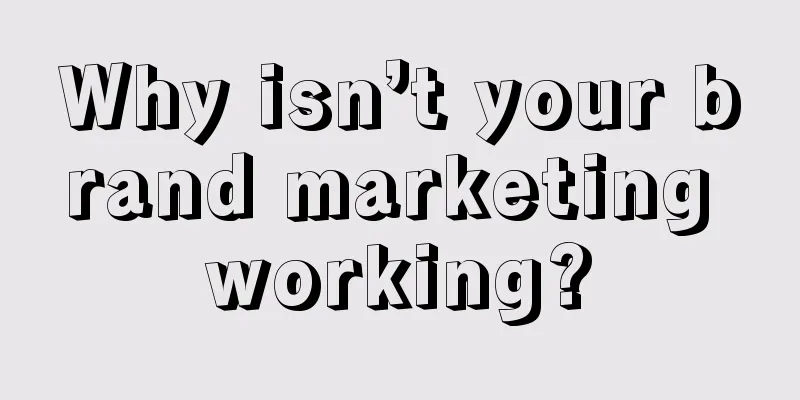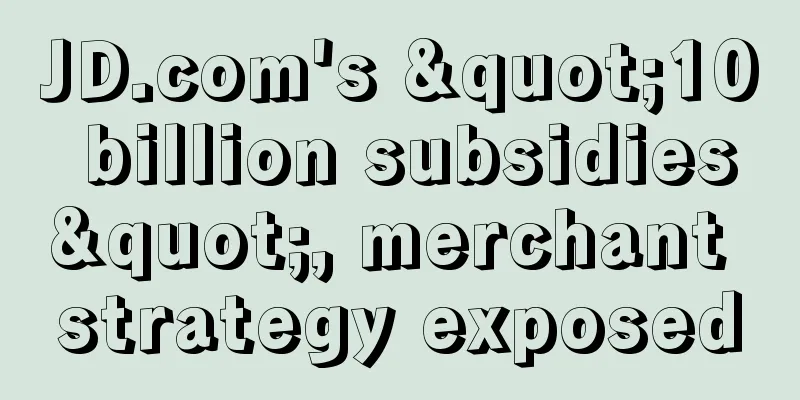Why isn’t your brand marketing working?

Regarding brand marketing, there is something that recently gave us some inspiration. The thing is, a 3-minute video about the "History of Women's Hairstyles" has become a hit, and I believe many people have seen it. But what I want to talk about is not how well-made the content of this video is, but the inspiration it has given to brands during the dissemination of this video. I personally have seen this video many times on TikTok, Video Account, and Bilibili, but I never had the patience to watch it in its entirety. But it wasn’t until this video became popular on Twitter and someone retweeted it and commented “watched to the end” that I finally had the patience to jump directly to the end of the video. The video ends with a reversal of content, telling the story of a girl who was bullied online for dyeing her hair. The "history of women's hairstyles" in the previous part of the video is all paving the way for the final reversal. This content presentation method is very similar to traditional commercials, and the "freedom to dye hair" is similar to brand value, which is always hidden at the end to sublimate the main theme. "Look at Her from the Head" 1920-2020, a Century of Changes in Chinese Women's Hairstyles, UP Host: Duoduo Hualin Although "History of Women's Hairstyles" has achieved a certain degree of breakthrough, but without the comments and prompts of users, I am afraid that most people will not be patient enough to watch to the end. Even with the prompt of "watch to the end", many people still jump directly to the end. This actually means that the conversion efficiency of this long video is extremely low, and a lot of information in the middle, although very hardcore and sophisticated, is actually almost useless information. This actually reflects the crux of current brand communication and also gives us some inspiration. 1. Make up your mind to say goodbye to long video adsThree years ago, we began advising brands not to run long brand-oriented video ads. This is because, apart from offline events and press conferences where long video ads can be shown, I really can’t think of any scenario in which users would have the patience to watch brand ads that last several minutes. The change in the length of advertising content is actually closely related to the change in the length of time users can concentrate. Obviously, under the discipline of self-media and short videos, users' attention is becoming more and more scattered and difficult to concentrate. This is also the reason why the public is becoming more and more anxious. On the one hand, their attention is not focused, and on the other hand, more and more information is flooding social media. In the context of the collective shortening of public attention, making long videos is obviously going against the trend. We have been in contact with a large number of advertising and marketing teams in the past, and I can also say directly that none of the content produced by long videos has really become popular. Long videos are more of a "product" delivered to brands, and there is no expectation that they can really form a communication effect. The decline of long content is also reflected in various media such as entertainment graphics, H5, and audio. It is now extremely difficult to see the reverse WeChat public account advertisements that were popular around 2018. The number of long comic strips has decreased at a visible scale. H5 has now become just functional interactive content such as invitations and form tools. And long audio content such as podcasts can obviously only remain in the niche stage. Of course, long content still has its unique value, and we can see long content and even long ads breaking the circle from time to time. For example, a while ago, we noticed that Jiaoxia's "The Awakening" advertisement was forwarded by many people, which should be regarded as a good communication result. Under the Banana Tree: The Waking of Insects We have actually written an article before to analyze that the long video advertisement of "The Awakening" is not a story, but a music MV. It uses music to continuously stimulate and guide users to watch. Coupled with the remarkable production level, it can be said that it has achieved a breakthrough in communication. But in fact, even if Jiaoxia Communication has broken the circle, I personally have actually forgotten what brand content "The Awakening" wants to express. I believe that many users should be like me. They remember the brand advertising but have forgotten what the brand wants to express and convey. Therefore, there are at least three problems with long video content:
Despite sporadic cases of breaking out of the circle, we still do not recommend brands to create long video content. 2. Repeated brainwashing does not improve advertising efficiencyIn the past, there was an advertising theory that said that an advertisement needs to be exposed about 7 times in order to really attract the attention and reading of potential users. For example, it takes multiple exposures of advertisements on TV, in elevators, on mobile phones, in offline stores, and other user touch points to make users really interested and read the advertisement content. But in today’s information explosion, it can be said that if the content of the advertising material does not really hit the user’s heart, it is likely that it will be in vain no matter how many times it is repeated. If it is an ineffective advertising material, the more it is spread, the more it wastes the budget, and users will not really recognize the brand because of the repeated times. For example, in 2019, Focus Media proposed a theory called "super-overlay marketing", calling it a "nuclear weapon" to solve the current brand communication dilemma. The so-called "super-overlap marketing" is, in the words of Jiang Nanchun, "in Focus Media's elevator scene, a single brand's repetitive advertising film is played in rotation for a whole day, so as to combine the advertising content with specific scenes and specific times, and then produce a super-overlap effect, opening up a high-speed information channel for the brand to directly reach users." Yiche, the first case of “super stacking marketing”, was not subsequently promoted by Focus Media. We tend to believe that the original “super-superimposed marketing” theory was just something that Focus Media came up with in order to sell elevator advertisements. Now Focus Media hardly talks about the so-called “super-superimposed marketing” theory anymore. Perhaps this theory has been falsified. In fact, whether the advertisement is brainwashing or "super-stacked" is not the key to marketing success or failure. The key lies in whether the advertisement content really touches the real needs of users. A large number of brands are using the routine of brainwashing advertisements, but some brands can trigger topics and achieve brand mind position, but some brands obviously spent money in vain, and nothing was left after the advertisement was released. The insight of "more suitable for the physique of Chinese babies" is first of all accurate, and it is the pain point of user needs. Coupled with Focus Media's advertising, it can create Feihe's success in communication. If the advertising information itself is irrelevant, then even if hundreds of millions of dollars are spent on brainwashing, it will only be half the result with twice the effort. But good insights are actually scarce, so although Focus Media cooperates with a large number of major customers every year, in Focus Media's brand case packaging, it always talks about Feihe, Bosideng, and Meiji Landou over and over again. 3. Stop unnecessary advertising content involutionWith the improvement of the overall content production level of society, the issue of content has also entered an internal competition. The "hardcore" and "exquisite" videos that can be seen everywhere have long been nothing new to users. It is actually very difficult to impress users through information density and exquisite production, and we have reached a technical bottleneck . In our article about Bilibili, "Will UP Masters and Bilibili "Perish Together"?", we analyzed that excessive involution of content will actually cause the content to deviate from user needs and reduce content efficiency. In essence, users do not need "hardcore" content, but "useful" content. Blindly competing in production and research is inefficient. We have always believed that brand marketing needs to focus on the big picture and ignore the small details. The most important thing is the direction and strategy. As for whether the production is exquisite, it is actually not a very important thing as long as it does not affect the brand tone. We have met some brand managers who like to focus on the details of the advertisement. In fact, it is no longer necessary now. The key is to grasp the emotions and pain points of users. For example, in the video "History of Women's Hairstyles", users recognized the video not because of the high degree of restoration of the hairstyle, but because of the final reversal and sublimation of the subject. In other words, even if the first half of this "History of Women's Hairstyles" video was cut from 3 minutes to 2 minutes, it would not be a big deal, and it would even be easier to spread beyond the circle. The "content" of an advertisement should give way to the "topic". The angle and the entry point are the key to arousing user emotions, not the "content" itself. No matter how sophisticated the advertisement is, users are likely to just reply with a "great" and fail to generate a topic effect, so the ROI of the advertisement production is low. So, we often complain that brand advertising is not cost-effective or that ROI is hard to calculate, not because brand advertising is ineffective, but because companies use an inefficient and costly way to produce brand advertising. We have seen many new consumer brands spend huge sums of money on sophisticated brand advertising after raising money, and hire creative hot shops and big-name directors to shoot films at high prices, but in fact it is completely unnecessary. 4. PR operation is the core of brand breakthroughThe declining efficiency of advertising can be compensated by public relations. For example, during the dissemination of the video "History of Women's Hairstyles", the information flow of Douyin, Bilibili, and Video Account did not attract me to watch it, but the comments and reposts on Twitter did make me watch the end of the video carefully. In other words, the hard push of information flow and likes from friends on the video account are far less effective than the opinions and comments of KOL/KOC, which is essentially a means of public relations communication. Comments, reposts, interpretations and secondary creations of brand content are now more important than the brand content itself. The industry often recommends that brands build their own content assets, but more importantly, brands need to build their own KOL/KOC friend circles, which can drive the opinions, attitudes and emotions of circle users through content. So we can see that on content platforms such as Weibo, WeChat and Douyin, Xiaohongshu, and Bilibili, if the brand’s official video ads and graphic ads are not paid for, it is almost impossible for them to become hits through algorithms; and what can really become hits are still UGC content that is full of emotions and has clear opinions. UGC has actually become the link between brands and users. Therefore, while brand marketing content should directly hit the user's needs and pain points, in terms of public relations operations, the focus should be on the KOL and KOC levels. It can be said that brand content can only break through the circle if and only if it is fermented by KOL/KOC (expressors). Author: Tang Xiaoquan, Zheng Zhuoran Source: WeChat public account "Spread Gymnastics (ID: chuanboticao)" |
>>: Redefine "consumption attributes" and your products can be sold at a higher price!
Recommend
No collapse, no rest, and low cost, can digital humans subvert live streaming e-commerce?
In the future, what role will digital people play ...
Can I only cancel my cross-border e-commerce account once? How do I register for a cross-border e-commerce account?
In the process of cross-border e-commerce industry...
If your boss doesn’t understand data, are you still data-driven?
Regardless of the industry, data-driven work has b...
TVB artists promote products on Taobao: Many watch the shows, but few pay for them
This article starts with the cooperation between T...
How to ship goods when doing cross-border e-commerce at home? How to send express delivery?
When doing cross-border e-commerce, after receivin...
What to do if Amazon traffic is only in the tens? How to improve it?
After opening a store on Amazon, everyone will als...
Pinduoduo Temu releases Canadian glazed ceramic and glassware compliance requirements
Pinduoduo Temu platform has relevant requirements ...
Brand No. 1: (category + mindset + origin) x coverage
This article explains how to build a brand in four...
How will these 10 predicted trends affect the internet celebrity landscape in 2024?
In the past 2023, many influencers with our model ...
How long does it take for Amazon FBA to enter the warehouse? What should I do if the warehouse is out of stock?
Amazon is a very fair platform, which is also one ...
A tea brand "Yinian Caomuzhong" private domain growth case analysis, worth learning for everyone
At present, the development of the tea industry is...
Brand needs a good story
A brand needs a good story. The first step to tell...
Is eBay the only payment method for PayPal? How do I connect eBay to PayPal?
eBay sells thousands or even millions of items eve...
How much does it cost to transfer a Shopee store? How is the fee charged?
The stores on the Shopee platform can also be boug...
In the era of consumption downgrade, why did Luckin Coffee lower its prices and Moutai raise its prices?
In the era of consumption downgrade, why do some c...









